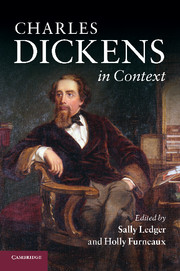Book contents
- Frontmatter
- Contents
- List of illustrations
- Notes on contributors
- Preface
- Notes on references
- PART I LIFE AND AFTERLIFE
- PART II SOCIAL AND CULTURAL CONTEXTS
- 12 Popular culture
- 13 The rise of celebrity culture
- 14 The newspaper and periodical market
- 15 Authorship and the professional writer
- 16 The theatre
- 17 Melodrama
- 18 The Bildungsroman
- 19 Visual culture
- 20 The historical novel
- 21 The illustrated novel
- 22 Christmas
- 23 Childhood
- 24 Work
- 25 Europe
- 26 The Victorians and America
- 27 Educating the Victorians
- 28 London
- 29 Politics
- 30 Political economy
- 31 The aristocracy
- 32 The middle classes
- 33 Urban migration and mobility
- 34 Financial markets and the banking system
- 35 Empires and colonies
- 36 Race
- 37 Crime
- 38 The law
- 39 Religion
- 40 Science
- 41 Transport
- 42 Illness, disease and social hygiene
- 43 Domesticity
- 44 Sexuality
- 45 Gender identities
- Further reading
- Index
22 - Christmas
Published online by Cambridge University Press: 05 August 2012
- Frontmatter
- Contents
- List of illustrations
- Notes on contributors
- Preface
- Notes on references
- PART I LIFE AND AFTERLIFE
- PART II SOCIAL AND CULTURAL CONTEXTS
- 12 Popular culture
- 13 The rise of celebrity culture
- 14 The newspaper and periodical market
- 15 Authorship and the professional writer
- 16 The theatre
- 17 Melodrama
- 18 The Bildungsroman
- 19 Visual culture
- 20 The historical novel
- 21 The illustrated novel
- 22 Christmas
- 23 Childhood
- 24 Work
- 25 Europe
- 26 The Victorians and America
- 27 Educating the Victorians
- 28 London
- 29 Politics
- 30 Political economy
- 31 The aristocracy
- 32 The middle classes
- 33 Urban migration and mobility
- 34 Financial markets and the banking system
- 35 Empires and colonies
- 36 Race
- 37 Crime
- 38 The law
- 39 Religion
- 40 Science
- 41 Transport
- 42 Illness, disease and social hygiene
- 43 Domesticity
- 44 Sexuality
- 45 Gender identities
- Further reading
- Index
Summary
John Forster, Dickens's first biographer, reflected in 1873 that his friend had ‘identified himself’ with Christmas, and noted that ‘its privilege to light up with some sort of comfort the squalidest of places, he had made his own’. From the earliest days of his writing career, Dickens had lighted upon Christmas as a season of good cheer and fellow feeling. In his youthful collection of journalistic pieces, Sketches by Boz (1836), he had celebrated the pleasures of Christmas thus:
Christmas time! … There seems a magic in the very name of Christmas. Petty jealousies and discords are forgotten; social feelings are awakened, in bosoms to which they have long been strangers; father and son, or brother and sister, who have met and passed with averted gaze, or a look of cold recognition, for months before, proffer and return the cordial embrace, and bury their past animosities in their present happiness. Kindly hearts that have yearned towards each other, but have been withheld by false notions of pride and self-dignity, are again reunited, and all is kindness and benevolence! Would that Christmas lasted the whole year through (as it ought), and that the prejudices and passions which deform our better nature, were never called into action among those to whom they should ever be strangers!
In the ‘good-humoured Christmas Chapter’ of The Pickwick Papers Dickens similarly venerates Christmas as a ‘brief season of happiness and enjoyment … How many old recollections, and how many dormant sympathies, does Christmas time awaken!’ (ch. 28).
- Type
- Chapter
- Information
- Charles Dickens in Context , pp. 178 - 185Publisher: Cambridge University PressPrint publication year: 2011

